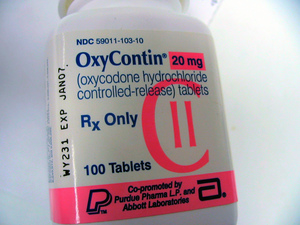OxyContin (oxycodone HCI controlled-release) is a powerful narcotic used to treat moderate to severe pain associated with arthritis, lower back conditions, injuries and cancer. Taken over the course of multiple days and administered every 12 hours, OxyContin tablets contain a time-release mechanism that allows its effects to remain active for the entire period of time. The drug has been controversial, however, because of its association to prescription drug abuse, pharmacy thefts, and risk of adverse side effects such as birth defects.
BIRTH DEFECTS
In March 2011, research was released linking opioid pain relievers, such as OxyContin, to serious birth defects. According to an ongoing study by the U.S. Centers for Disease Control and Prevention (CDC), there is a risk of congenital heart defects for the infants of women who take OxyContin right before or during pregnancy. Of the study participants, 2 to 3 percent received prescription opioid painkillers just prior to their pregnancy or early in the pregnancy. Illicit use of painkillers was not factored into the study. Through analysis of this data, the CDC found that women who took OxyContin doubled their risk of having babies with hypoplastic left heart syndrome, a critical heart defect. Risks are also increased for
 spina bifida
spina bifida- hydrocephaly
- congenital glaucoma
- and gastroschisis
Women who are pregnant or could become pregnant should be aware of the risks posed by prescription painkillers, including OxyContin. Although “the absolute risk for any individual woman is relatively modest,” said CDC epidemiologist Cheryl S. Broussard, “the severity of the life-threatening birth defects like hypoplastic left heart is cause for concern.”
CONGENITAL HEART DEFECTS
In the United States, there are approximately 40,000 infants born with congenital heart defects each year. Congenital heart defects include a wide range of issues with the function of the baby’s heart and can be deadly. Many infants with congenital heart defects will die within a year of birth. The survivors undergo multiple invasive surgeries, lengthy hospital stays, and face a lifetime of treatments. One of the causes of congenital heart defects is medication, both prescription and over-the-counter, that the mother took during pregnancy. Some drugs, such as OxyContin are already linked to this risk, and researchers are studying other drugs to see their effects, as well as environmental factors.
OVERDOSE & WITHDRAWAL DANGERS
 OxyContin abusers remove the sustained- released coating by crushing, chewing or boiling the powder for injection to get a heroin-like high. The rapid release and absorption of the potentially toxic dose of oxycodone can have fatal results. Reports indicate that hundreds of people have died from overdosing on OxyContin, most often because of acute pulmonary edema.
OxyContin abusers remove the sustained- released coating by crushing, chewing or boiling the powder for injection to get a heroin-like high. The rapid release and absorption of the potentially toxic dose of oxycodone can have fatal results. Reports indicate that hundreds of people have died from overdosing on OxyContin, most often because of acute pulmonary edema.
Chronic use of OxyContin is dangerous as well. Patients that develop an increased tolerance to the drug, requiring higher doses of the medication, can end up becoming addicted to OxyContin. As a result, when discontinuing the drug therapy a person can experience OxyContin withdrawal symptoms.
HISTORY
OxyContin was first marketed in 1996 with sales reaching $1.2 billion by 2003 and causing concern among many. According to FDA report, OxyContin may have played a role in 464 deaths across the U.S. from just 2000 to 2001, and the use as well as abuse of the drug continues to increase.
Because of the illicit use of OxyContin, some regulators have been trying to restrict the use and availability of the drug, pointing out that a lot of patients might be treated just as well, if not better, with another drug to treat their pain without the risks of OxyContin overdose or addiction. Numerous state legislatures are pushing for ways to limit the increasing rates of OxyContin abuse, including New York, where the state’s Legislature’s OxyContin Commission held a public hearing.
Proposed OxyContin controls recommended at the hearing included using OxyContin only as a last resort, and having health insurance providers allow a minimum of 60 days coverage in a treatment facility for a plan subscriber suffering from OxyContin addiction.
ACT NOW
If your child suffered birth defects that may be the result of OxyContin or for more information on OxyContin abuse, please contact the lawyers at The Oshman Firm for a free and confidential case evaluation. We will find answers, hold negligent companies responsible, and fight to get you the compensation you deserve.
